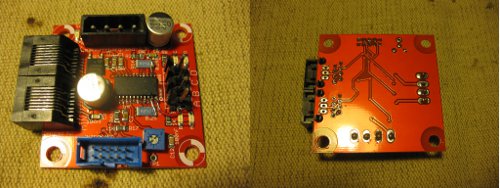I’ve been playing with my CNC Mill project a little bit in some “spare” time(= time I should be working on things for school, but can’t focus), and just got my third RepRap Stepper Motor Driver v2.3 working after some replacement parts and judicious green-wiring.
I bought three drivers as kits, because they were cheap and well regarded, but the boards are largely surface-mount, and the first attempt to populate them didn’t go well, thanks to distorted lead frames and UK’s shifty surface mount equipment. With a little bit of hand soldering to fix lifted pads, I got two of the three boards going, but one of them …ignited… when tested because of a lifted ground on the main IC. The bad board has been sitting in it’s bag waiting for me to do something about it for most of a year now, and the other night I realized I could probably remove the chip, order a replacement Allegro A3982 from one of the electronics suppliers for a couple dollars, and try again. Pulling the chip by hand lifted four pads, but left it looking workable, so I picked up a pair of spare chips from DigiKey (who, for a pleasant but startling change, only charged me a very modest shipping fee).
My replacements arrived earlier today, and I couldn’t resist taking a crack at it. As the title suggests, this resulted in a UGLY but working driver board (click for larger):

Check out the run of magnet wire across the bottom of the board, up through a via, and then under the pad it goes to. That is some quality fabrication (also, I checked, that path never carries much current, so magnet wire is OK). The other fixes are all relatively easy (and large-current) runs across one side of the board.
This time, instead of catching fire and destroying an IDC cable, connecting power and my supremely ghetto-rigged test circuit (a 555 timer set up to generate a pulse train on step, and some buttons and switches to control direction and enable) resulted in a smoothly turning motor. Success. I’ll probably only have to make one more small electronics order (remember that melted IDC cable…) and all the drive electronics will be together to run it from a EMC2/Linux box.
The hangup now is the connections between the axes and the drive nuts: my old bent-steel-sheet brackets were not square enough, and were causing walking and uneven tension and all manner of badness, but I haven’t managed to design a replacement I’m both satisfied with and able to build/source. If anyone has an idea for mounting a 1.25” long, .56” flat-to-flat hexagonal coupling nut to a metal panel 1” away from the rod the nut rides on, which will take large lateral torque and remain square to the rod, let me know. I have a half-baked plan with some modified heavy L-brackets, but there must be something better.

